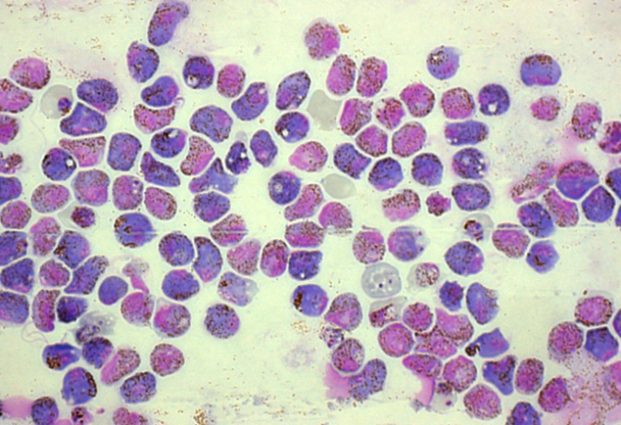
Read the latest Issue
Study into the reproduction of malaria parasites reveals faster and broader protein regulation than expected

A study led by researchers at the European Bioinformatics Institute (EMBL-EBI) and the Wellcome Trust Sanger Institute gives new insights into the life cycle of malaria-causing Plasmodium parasites, as they are transmitted from mammal to mosquito. Using mass spectrometry and computational biology, the collaborators explored what happens during this rapid process, which spurs the spread of the deadly disease.
We spoke to first author, Brandon Invergo, ESPOD at EMBL-EBI and The Sanger Institute, to find out why these new insights are important for understanding malaria.
During one stage of their life cycle, malaria parasites have male and female ‘gametocyte’ forms, which play an important role in Plasmodium reproduction. These gametocytes linger in the blood of mammals, waiting to be ingested by mosquitoes. As soon as they get into the mosquito, they swing into action.
Within ten minutes, the male gametocytes undergo several extreme changes: they reproduce their genome three times and go through three rounds of endomitosis (when newly copied chromosomes are separated within the cell nucleus). This produces ‘microgametes’: sperm-like structures that make their way to female gametocytes and reproduce. The cells produced in this process can leave the mosquito’s body to infect another host – for example, a person.
Researchers have observed this process for years, yet we know very little about how it works at a molecular level.
We tracked gametocytes from the moment they are ingested by a mosquito. We looked specifically at the protein signalling involved in controlling that crucial first minute in the mosquito’s body, when the gametocyte is activated.
To get a clear picture of what is happening, we used mass spectrometry to investigate protein phosphorylation – a measure of proteins being activated, deactivated or modified. Protein phosphorylation is a good indicator of what is happening in a cell at any given time.
My colleagues and I focused primarily on the first 18 seconds of the process. We took a ‘snapshot’ of phosphorylation levels every six seconds, which allowed us to identify which proteins undergo changes during that critical first stage of reproduction.
The breadth of activity was unlike anything we expected to see.
We found hundreds of proteins that are phosphoregulated simultaneously within the first 18 seconds of gametocyte activation. This insight could help us understand protein activation. That would point us to which proteins play an active part in the transmission of the parasite at this stage.
Understandably, the majority of the proteins being regulated when reproduction kicks off are related to the cell cycle. What we found most interesting was the near-simultaneous regulation of proteins that are related to different steps in the cell cycle.
Typically, the cell cycle is considered to be a rigid series of steps that happen one after the other – not all at the same time. The findings suggest a potentially different mode of regulation within the malaria parasite. While there have been hints of unusual cell cycle behaviour in malaria parasites, this is the most direct evidence yet that these species do things differently.
We know very little about the malaria parasite, especially when it comes to the function of its different proteins. Our study suggests that processes in the cell cycle are occurring simultaneously. This contradicts our usual understanding of cell cycle biology. Also, the speed with which the process happens is extremely interesting. We expected it to be fast, but not quite this fast.
If we want to have any hope of reducing malaria infection rates, we need to understand how the parasite works. This type of research helps us break down what is happening in the parasite at a molecular level. It could also help us identify proteins that, if targeted, could stop the transmission of the parasite. This would block the malaria from infecting a new host.
This study focuses on the fundamental biology driving malaria. While it may not lead to the eradication of the parasite, it offers new insights that can direct future research.
This research wouldn’t have been possible without collaboration. EMBL-EBI and the Wellcome Trust Sanger Institute’s Proteomics Mass Spectrometry lab and Malaria Programme worked closely on the project. I’m an EBI–Sanger postdoctoral (ESPOD) fellow. This allows me to focus on projects that combine experimental (wet-lab) and computational (dry-lab) approaches.
This post was originally published on EMBL-EBI News.
Looking for past print editions of EMBLetc.? Browse our archive, going back 20 years.
EMBLetc. archive